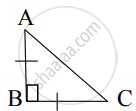Advertisements
Advertisements
प्रश्न
The sides of triangle is given below. Determine it is right triangle or not.
a = 8 cm, b = 10 cm and c = 6 cm
उत्तर
In order to prove that the given sides of a certain triangle forms a right angled triangle we have to prove that square of the larger side is equal to the sum of the squares of the other two sides.
Here, the larger side is b = 10 cm.
Hence, we have to prove that a2 + c2 = b2.
Let solve the left hand side of the above equation.
a2 + c2 = 82 + 62
= 64 + 36
= 100
Now we will solve the right hand side of the equation,
b2 = 102 = 100
Here we can observe that left hand side is equal to the right hand side that is a2 + c2 = b2 .
Therefore, the given sides of a certain triangle form a right angled triangle.
APPEARS IN
संबंधित प्रश्न
A ladder 17 m long reaches a window of a building 15 m above the ground. Find the distance of the foot of the ladder from the building.
Two poles of height 9 m and 14 m stand on a plane ground. If the distance between their feet is 12 m, find the distance between their tops.
Each side of a rhombus is 10 cm. If one of its diagonals is 16 cm find the length of the other diagonal.
In an acute-angled triangle, express a median in terms of its sides.
In an equilateral ΔABC, AD ⊥ BC, prove that AD2 = 3BD2.
State the converse of Pythagoras theorem.
If D, E, F are the respectively the midpoints of sides BC, CA and AB of ΔABC. Find the ratio of the areas of ΔDEF and ΔABC.
Find the diagonal of a rectangle whose length is 16 cm and area is 192 sq.cm ?
From given figure, In ∆ABC, AB ⊥ BC, AB = BC then m∠A = ?
From given figure, In ∆ABC, AB ⊥ BC, AB = BC, AC = `5sqrt(2)` , then what is the height of ∆ABC?
